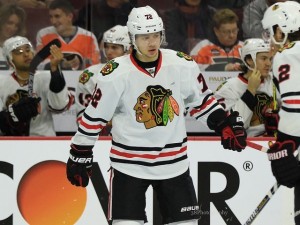Not much has changed for the Chicago Blackhawks’ core roster since they won their first Stanley Cup of this generation back in 2010. Toews, Kane, Hossa, Keith, Hjlarmarsson, and Seabrook are all names that fans and opposing players have grown accustomed to seeing in the Indian-head sweater on a yearly basis. It goes without saying though that these players won’t be around to carry the team forever and that new players will soon be needed to bring the franchise into the future.
Brandon Saad was thought to be one of Chicago’s future stars, but four other young players have taken his place as the most important skaters for the future of the Hawks. Those four are Artemi Panarin, Teuvo Teravainen, Marko Dano, and Trevor van Riemsdyk. Together, their youth, potential, and contract situations give them the unique opportunity to be added to an elite group of core players starting in 2017.
Age Factor
It’s no secret that players such as Marian Hossa (36) and Duncan Keith (32) aren’t getting any younger and likely won’t be able to sustain their current levels of production for too much longer. And even though Hossa claims he would love to play as long as Jaromir Jagr has, counting on him to do so would be irresponsible for Hawks management.
So where does that leave Chicago’s forwards? Kane and Toews are still just 26 and 27 (remarkably so given all that they’ve accomplished already), but there is a definite talent drop-off behind those two. Meanwhile, Dano, Teravainen, and Panarin are all under 23 years old and have already shown the ability to produce offensively at the NHL level.
Panarin and Teravainen currently sit 2nd and 4th on the Blackhawks in points while Dano tallied 21 points in 35 games with Columbus last season. Normal NHL production trends suggest that these three are all primed to see big scoring increases as they play more games at the NHL level, so production at this stage of their careers is very promising.
Potential
The potential of those three forwards may take some time to be fully realized, but van Riemsdyk hasn’t wasted any time showing coach Joel Quenneville that he can be a valuable NHL defenseman right now. TVR isn’t asked to play the other team’s top players, nor is he asked to kill penalties on a regular basis, but he has performed well in the ice time he’s been given.
Not only has he chipped in offensively with 2 points through 6 games, but he’s also recorded the best 5v5 ZS Adj CF% of any regular on Chicago’s blue-line. Additionally, he is almost always asked to play with the newly acquired Trevor Daley. Daley is new to Quenneville’s defense-first system after being allowed to freewheel in Dallas and has shown a steep learning curve so far.
His aggressive – and occasionally reckless – play has left van Riemsdyk as the sole defender back on more than one occasion this season already, and so far he has handled the pressure very well. Since a rough first game against the Rangers that saw him get caught out of position on multiple offensive plays for New York, the former New Hampshire standout has been a steadying presence on the back end when called upon.

Contract Situations
Any discussion of the future of the Blackhawks has to involve the salary cap in some capacity when Toews and Kane alone account for $21 million of it on an annual basis until 2023. The three forwards in this group all have contracts that run until the end of the 2016-17 season and should all be just starting to scratch the surface of their potential as pros at that time.
It is also important to note that Marian Hossa will be 38 at that point – an age that most NHL players struggle to play until. Additionally, Artem Anisimov will be entering his second year with a cap hit of $4.55 million as part of a contract that runs until 2021. While it would be great to be able to keep both of these two-way forces until the end of their respective deals, an emergence by any one of Teravainen, Dano, or Panarin could make them both expendable. Using that saved cap room to sign their emerging young players to long term deals would dramatically alter the state of the Hawks’ core and set them up for another decade as competitors.
It is also important to remember that Panarin’s current deal is bonus eligible, meaning that he could take up a larger portion of the salary cap next season if he continues to perform as well as he is right now. With the team already tight against the cap for 2016-17, Panarin’s production could actually force the team to move additional players to create room for his bonus overages.
For van Riemsdyk, his continued improvement could eventually allow Stan Bowman to trade away Brent Seabrook as he increases in age and salary. Under contract for two more years after his entry-level deal expires at the end of the 2015-16 season, van Riemsdyk has plenty of time to develop into an impact player on the right side of Chicago’s blue line.
The Blackhawks likely have around 3-5 more years as top competitors with their current core intact and no further development from this quartet of talented youngsters, but improvement on their part could alter the landscape of the team long-term and actually contribute to a longer period of sustained success.